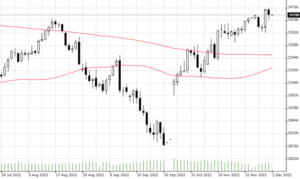

02.12.2022 – Has Wall Street shifted up a gear? The ongoing bull market almost looks like it. Or is the year-end rally simply already underway? And a lot of capital is flowing into the market as many expect things to normalise. As always, a lot depends for traders and investors on the US economy and the Federal Reserve’s possible reaction. Today, Friday, important jobs data arrive in this regard.
In view of the current general weather situation, one can already feel queasy when looking at the Dow Jones. The daily chart clearly shows the euphoria of the past few days – the gap speaks volumes. And the index has easily left behind both the 50-day and the 200-day moving average (above).

Source: Bernstein Bank GmbH
Yet the situation is not all that rosy. Corona seems to be over, but as the example of China shows, the issue has by no means disappeared. A recession is still possible. So the old economy is taking a big leap of faith from investors.
Soft tones from the Fed
Above all, the nice interim rally on Wednesday stands out. It was triggered by Jerome Powell. Let’s let an expert from an investment boutique have his say again: Kenny Polcari, Managing Partner at Kace Capital Advisors and Chief Market Strategist at SlateStone Wealth, judged that Powell had communicated that the speed of the rate hike would slow down and that there would only be a 50 basis point increase in the key interest rate in December.
Especially important: Powell and his colleagues did not want to tighten the screw too much. The danger of this “overtightening” had repeatedly put the brakes on the buying mood in recent months. Now the brake seems to have been removed. Moreover, Powell said that some sectors of the economy were already reacting to the past six interest rate hikes – especially the real estate market and rents. The Fed chief’s appearance before the Hutchins Center on Fiscal and Monetary Policy has attracted special attention because it was the last public speaking engagement before the blackout period to the December 13-14 Fed meeting.
New jobs data
The bulls could get new fodder from today’s jobs data. By the time you read this, you may already know more about the Nonfarm Payrolls for November. If the labour market continues to boom, the Fed would have to counteract a wage-price spiral with higher interest rates. However, Powell’s recent words tend to suggest that employment is flagging and that wages are not overheating. We are intrigued.
John Flood, trader at Goldman Sachs, judged that the market is still stuck in a “bad is good” mood. He summed up the possible reaction to the November numbers for the SPX like this – where we assume a similar reaction in the Dow:
– >261k (aka higher than last print) S&P down at least 2%.
– 175k – 261k: S&P down 1 – 2%
– 125k – 175k: S&P up 50bps – 1%
– 0 – 125k: S&P up 1 – 2%
– <0: S&P down 1 – 2% on R word fears
Our conclusion: On the one hand, the market is wavering between hopes of an easing of inflation – ergo a scaling back of tightening by the Fed. And on the other hand, fears of a recession. Whether long or short: Bernstein Bank wishes you good luck!
__________________________________________________________________________________________
The content of this publication is for general information purposes only. In this context, it is neither an individual investment recommendation or advice nor an offer to purchase or sell securities or other financial products. The content in question and all the information contained therein do not in any way replace individual investor- or investment-oriented advice. No reliable forecast or indication for the future is possible with respect to any presentation or information on the present or past performance of the relevant underlying assets. All information and data presented in this publication are based on reliable sources. However, Bernstein Bank does not guarantee that the information and data contained in this publication is up-to-date, correct and complete. Securities traded on the financial markets are subject to price fluctuations. A contract for difference (CFD) is also a financial instrument with leverage effect. Against this backdrop, CFD trading involves a high risk up to the point of total loss and may not be suitable for all investors. Therefore, make sure that you have fully understood all the correlating risks. If necessary, ask for independent advice. CFDs are complex instruments and are associated with the high risk of losing money quickly because of the leverage effect. 68% of retail investor accounts lose money trading CFD with this provider. You should consider whether you understand how CFD work and whether you can afford to take the high risk of losing your money.7
